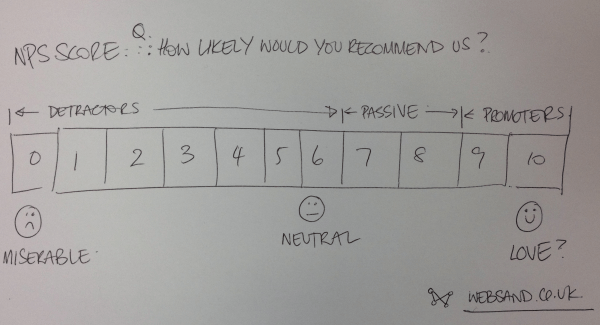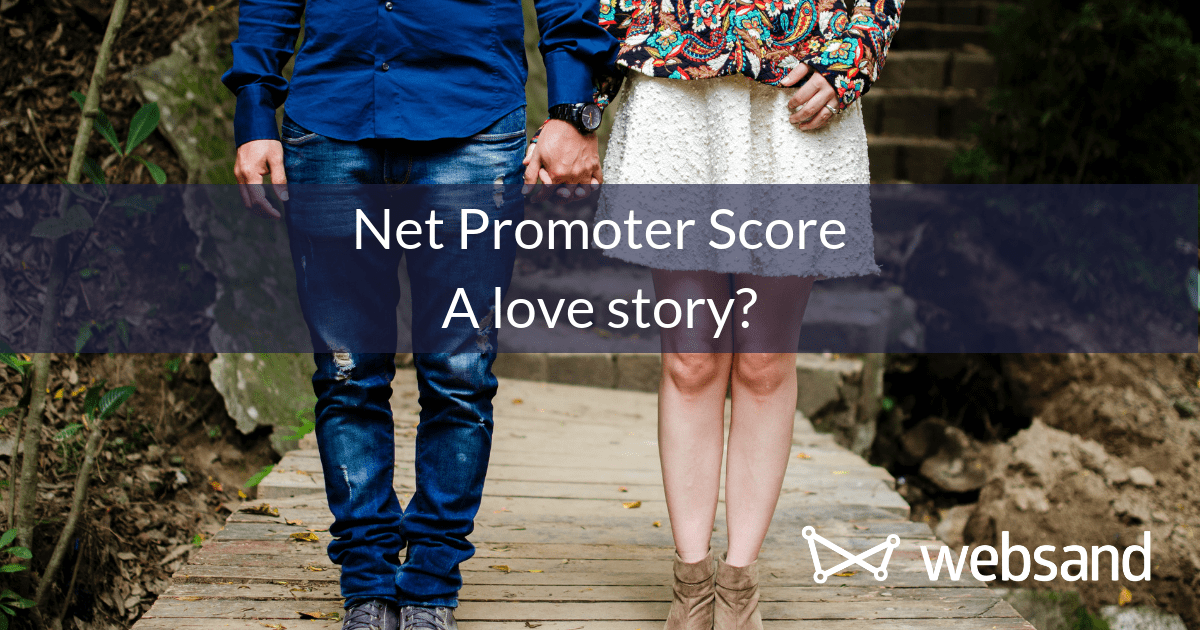Net Promoter Score: A love story?
Valentine’s day is upon us and I (like you) have been inundated with loads of promotional messages. It seems every business is embracing this ‘marketing event‘ to create more business for themselves.
Websand is no exception, this is a blog post about finding love.
But it is about the love between a business and their customers. How to use the Net Promoter Score metric, and how some suggestions on how you can retain and build customer loyalty through a bit of clever communication.
Get this right and you’ll be identifying customer love everyday – whether it’s Valentine’s Day or not!
Finding the love aka Net Promoter Score
Your Net Promoter Score has been referred to as the one number you need to know. But what is it and how do you use it?
In plain English, net promoter score is your likability rating, based on asking this simple question to your customers.
On a scale of 1 to 10, how likely is it that you would recommend [your company] to a friend or colleague?
If you are using net promoter score, then you’ll rate the answers as follows (based on the score you’ve been given)
- 9-10 are loyal enthusiasts.
- 7-8 – they are happy, but could leave at anytime
- 0-6 – a mix of not that happy, and damn right miserable.
Your NPS score is the average of all the answers, and the same rating would apply, so if your average is between 0-6, then you have some room for improvement :).
Embrace the positive, learn from the negative
The strange thing with the Net Promoter Score is that people gravitate towards the unhappy customers, and trying to make them happier, move them from a score of 2 to an improved score of 7.
This is a huge shift of 5 points which would move that customer from ‘miserable‘ to ‘OK but could leave at any time‘.
I suppose human nature is to fix a problem when a problem arises.
However, it’s important to consider the amount of time, effort, coercion and resource involved to move someone 5 points along the Net promoter score scale.
See my very basic scribble below.

Everyone works to a budget, so perhaps focusing on ‘changing the minds’ of those that aren’t convinced isn’t the best use of valuable resources.
I’d suggest using the same resources towards those customers who are your loyal enthusiasts; the people that really love what you do, your biggest fans will have a much more positive impact on your business.
Keep the Love
So, you’ve identified a group of people that really love what you do. This data is has a huge value. It’s a massive opportunity to grow your business with the ‘right’ kind of customers.
According to pretty much every social study, it turns out that people tend to be friends with people that share the same interests and tastes. This is great news for your business!
If you can turn your ‘best customers‘ as sales people for your business then the chances are they will target people like themselves. That means more future ‘best customers’ for your business.
So that is the good news.
The bad news is that this data is time sensitive and needs to be handled with extreme caution.
You need a subtle approach and it needs to be a win-win-win.
That means the existing customer – that loves what you do – needs to be rewarded.
The friends of your existing customer – need to be rewarded.
If you get that win-win balance correct.
Then you win. So it becomes a win-win-win.
How do you find the win-win-win?
The honest answer is that it depends on your business, and what you offer.
Finding a win-win for a high street retailer such as Paperchase is completely different to finding the win-win for a subscription business such as Spotify.
However, the objective is the same for both, namely to turn your best customers as sales people for your business.
So here is a process to follow to give you a framework to put some ideas into play.
Use the individual NPS score
From your Net Promoter Score, you know the people that love your business. Ideally, you will (or should*) know how long these people have been a customer and how much they are worth to your business.
Link it to Customer Lifetime Value
Let’s say that your best customer on average spends £500 per year and they have been a customer for 3 years. Then you could consider the current lifetime value of your best customer to be worth £1500.
If your margin is 33% then that customer has generated £500.
Knowingly reward the audience
How much would you pay to find another customer that would generate you £500 in profit over 3 years?
Let’s say that your answer is “£100”. If so that £100 represents your ‘incentive pot’. That is your budget to reward both parties. So £50 for the existing customer and £50 for the new customer.
I’d suggest that’s a good deal for everyone. And better still you only need to pay for the incentive when you find a new ‘best’ customer. 🙂
Some tips on putting the win-win into play
Consider the following when developing your plans.
Make sure that you don’t give it away.
It should only be paid out when a new customer signs up or spends over a certain amount. Make sure that the reward is fair.
Test the reward
Try the offerings with a selected few before pushing it out to a wider audience.
Set your success measure
Remember to set your success measure before you test. So you don’t cheat yourself into thinking something that really didn’t work, actually really did!
That’s all for now. Happy Valentine’s day and share some love.
S.W.A.L.K.
Find your best customers
Websand can show you who your best customers are, and help you revolutionise your business. You’ve got all the raw ingredients, we can show you the best recipes for success.
If you don’t already know who your best customers are, or their value to your business then get in touch and arrange a chat on the calendar.
It’s time to start getting more from your email marketing
Sign up for a free Websand demo and let’s show you how to get the best from your email marketing.
